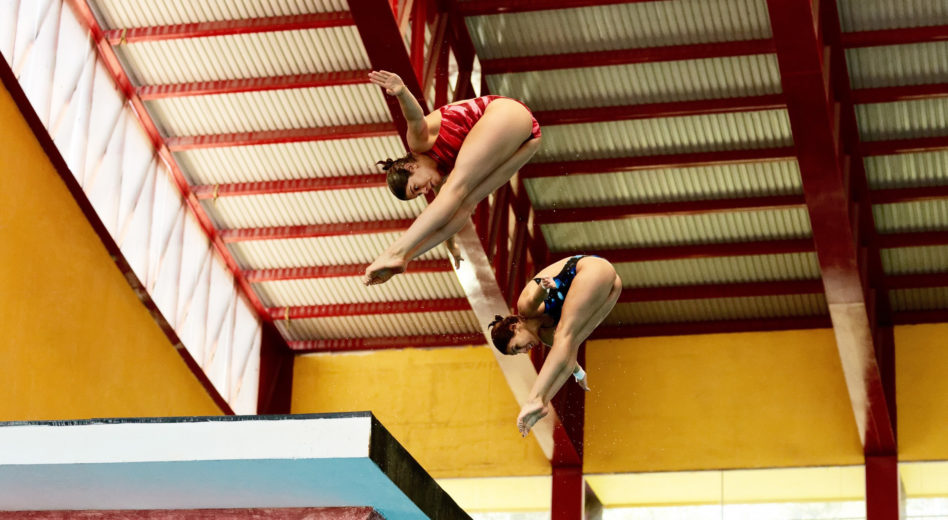On July 31, 2012 at the London Aquatics Center, Paola Espinosa and Alejandra Orozco step out of the poolside hot tub, towel off and scale three ladders to arrive atop the center’s ten-meter-high diving platform. Dressed in matching blue Team Mexico swimsuits, they silently repeat positive mantras: “Yes, you can.” “You can do it.”
The pair turns their backs to the pool, perching similar 5-feet-1-inch, 104-pound frames on the platform’s edge, gripping the brink with solely their toes. Each closes her eyes and draws a deep breath to slow her heartbeat, manufacturing a moment in which the slap of the pool drain and the cheers of the crowd disappear. They visualize their synchronicity, then Espinosa softly counts aloud: “One, two. One, two.” In unison, they spring into the air, twisting to the left before hinging at the hips, legs arrow straight to form a perfect pike as they begin their rapid descent.
Synchronized diving, which takes place from either a three-meter springboard or ten-meter platform, became an Olympic sport in 2000, although it had been publicly performed since the 1930s in diving shows and aquacades. In its competitive form, the contest features teams of two divers who perform simultaneous dives of five types: forward, backward, inward, reverse and twisting.
The elder of the pair, Espinosa was born in La Paz, Mexico, the capital city of Baja California Sur, in 1985. The firstborn daughter of two athletic parents, she was introduced to gymnastics at the age of three, then swimming, her father’s sport, but neither stuck. So at the age of five, she tried diving. “I was scared at first,” Espinosa recalls. “Then in my first competition at six, I got second place and I wanted to win. That’s where it all started.” A year later, she saw the Barcelona Games on TV and set her mind on winning a medal. At the age of 11, spurred by her family’s support and an invitation from the Mexican Olympic Committee to train in its program, Espinosa moved alone to Mexico City to pursue her dream.
The diver’s intense determination and focus, her mother Irma Josefina Sanchez Davila explains, was evident even before she was born. While pregnant with Espinosa, Davila recounts, doctors told her that she had a tumor that could cause either she or her daughter to die. Both survived, Davila says, because Paola is a fighter, and she believes this early trial developed her daughter’s inner strength.
Whatever the genesis of her resolve, following her arrival in Mexico City, Espinosa began defeating older competitors. Around this time, she also chose to focus on the 10-meter platform, rather than the springboard, because there were fewer females in the category. Eight years later, she was representing her country in Athens in the synchronized 10-meter platform event. Her first medal, a bronze, arrived in 2008 at the Beijing Games, an achievement that was both gratifying and motivating. “It made me want to practice more and more,” she explains. “I wanted to win more and to be the best.”
While Espinosa was stepping up to the pedestal, Orozco was just stepping onto a board. Born in Guadalajara in 1997, she discovered diving at age 10 while visiting a local athletic center, where she was captivated by the idea of springing off a platform into the pool. A local instructor soon noticed the young talent. “My coach would say, ‘I want you to go up and do this dive,’” Orozco remembers. “And I would. I think that’s what they saw in me: the desire to do the things the other girls wouldn’t do.”
This daring translated into competition wins, which in turn led Orozco to believe that perhaps what her coach said was true — maybe she could achieve something in the sport. Her opportunity to test that prospect arrived just a couple of years later when her idol, Espinosa, asked her to be her 10-meter partner. “It was a dream come true,” Orozco remembers. “I thought Paola was on another level, but she trusted me and that gave me confidence.”
Which returns us to London. Espinosa and Orozco simultaneously twist, tuck and flip, cleanly slicing the pool’s surface at the same instant. Earning 8 and 8.5 scores for a total of 343.24, their performance secured the silver medal, making Espinosa one of two Mexican women ever to win two Olympic medals and designating the then-15-year-old Orozco as Mexico’s youngest Olympic medal winner ever. In a post-competition interview, Orozco, showcasing an easy grin, dimples and saucer-like eyes, thanks her country for its support and expresses her extreme joy. Looking back on that moment nearly four years later, however, Orozco is less effusive. “It has been very difficult,” she says. “I achieved my dream, to win a medal with my idol, at such a young age that I didn’t even realize it until later. It was one of the greatest things, because I had admired Paola all my life. But then I said, ‘What’s next?’”
For her part, Espinosa took the moment to return home, where she too encountered an unexpected trial. “After London,” she says, “I wanted to come back home — to be a normal girl, a family girl.” But when her father, her biggest fan, passed away, it caused her to question her future. The support of her mother and sister helped Espinosa rediscover her diving focus and awoke a desire to compete in Rio. “There’s a difference between what you want and what you desire,” she clarifies. “And, for me, desire has a stronger pull.”
Upon returning to Mexico City, Espinosa contacted Pedro Ignacio Gato Cruz to drive her toward her new goal. Cruz, a renowned trainer and sports physics professor, came to Mexico from Cuba in 2006. His work with the Taekwondo Federation of Mexico and its athletes ahead of the 2012 Games brought him to Espinosa’s attention, for whom he tailored a new training regime focused on anaerobic exercises that increase strength and muscle explosiveness. “To dive you have to be strong, very strong,” Espinosa explains. “That can look a lot of ways. Divers all have different bodies and different strengths. There isn’t an archetype of what a diver’s body should be.”
“It’s dangerous. I love that fear and adrenaline.”
As Espinosa looked toward the future, Orozco grappled not only with articulating a new dream but also with the physical changes that occur as an adolescent becomes an adult. Crucially, her center of gravity had shifted, challenging the pair’s previously achieved synchronicity, the cornerstone of their success. Evidence of both struggles was on display in 2014, when the team placed sixth in a key international competition. Reflecting on her journey, Orozco says, “It is a weight carrying a medal on your back. There are a lot of people who have a lot of expectations of me. They think, ‘Oh, she won a medal. She has to win more and more.’”
Not long after that sixth-place finish, Orozco moved to Mexico City, where she could train daily with Espinosa at the Centro Acuatico Ceforma. Located in Southern Mexico City, an approximate 30-minute drive from the city center, past the home stadium of the Pumas football club, sinuous freeways, corporate headquarters and countless parks, framed by distant blue mountains, Ceforma was built for the 1968 Games and still boasts earmarks of the era. Golden yellow walls, fire-red rafters and cobalt blue diving platforms form graphic lines, framing three Olympic-size pools. A massive banner of Espinosa captured in a moment just before takeoff adorns the far wall.
For the past eight and a half months, Espinosa and Orozco have convened in the space. Five to six days a week, they balance dry-room work with diving, always under the watchful eye of Ma Jin, Team Mexico’s diving coach. Jin, originally from China, has worked with the team since 2005 and is considered a hero in the country for her contribution, which has elevated the team’s technique, precision and strength — and its overall performance on the world stage. The pair also trains five days a week with Cruz. Monday, Wednesday and Friday they do lifts. Tuesday and Thursday, the duo moves to resistance training and cardio work, which helps tears in the muscles to heal more quickly. And to maintain their energy, they rely on an unrestricted, yet protein- and amino acid-rich diet. Meals range from seafood and nutritional shakes to tortas de tamal, a notoriously decadent local dish that features tamales served in sandwich rolls.
This ultimately balanced, yet wieldy diet mirrors Espinosa and Orozco’s overall approach. They take their work extremely seriously, but solemn moments are offset by periods of mirth, with the elder diver often prompting her partner to dissolve into giggles, evidencing the pair’s yin-and-yang personalities as well as their age difference.
“We’re very different,” Espinosa confirms. “I am decisive and aggressive. Ale’s more introverted. I am always making jokes. I have a strong character. Maybe that has caused me trouble once in a while, but this is the way I am. I don’t get stuck on anything. I let everything go and just move forward.”
The key to reconciling divergences of all types, both divers assert, lies in dialogue. “Good communication is essential,” declares Orozco, “and having a good relationship and real communication outside of that one second of diving is more important than that second. Paola is like my sister.”
The equation, with all its variables, appears to be paying off. Instead of upsetting their synchronicity, the pair’s new physical differences have begun to counterweight Espinosa and Orozco’s respective strengths. “Now Ale’s a little bit taller than me, but I naturally jump a little bit higher,” explains Espinosa, “so I meet her in the air.” The pair’s steady progress is fueling them as they look to the summer when, as their country’s best chance for a podium-top win, they will concentrate four additional years of sacrifice and toil into that second-and-a-fraction plunge. But for Espinosa and Orozco, the rush always comes before the gold. “It’s dangerous,” Orozco states, “I love that fear and adrenaline.”
“You feel fear, anxiety, insecurity when you walk up the stairs onto the platform,” Espinosa adds. “But then there is a second before you jump, when you feel an intimacy with yourself. You know how to handle yourself; you can control yourself. That’s the moment that I like the most: I love the butterflies.”

